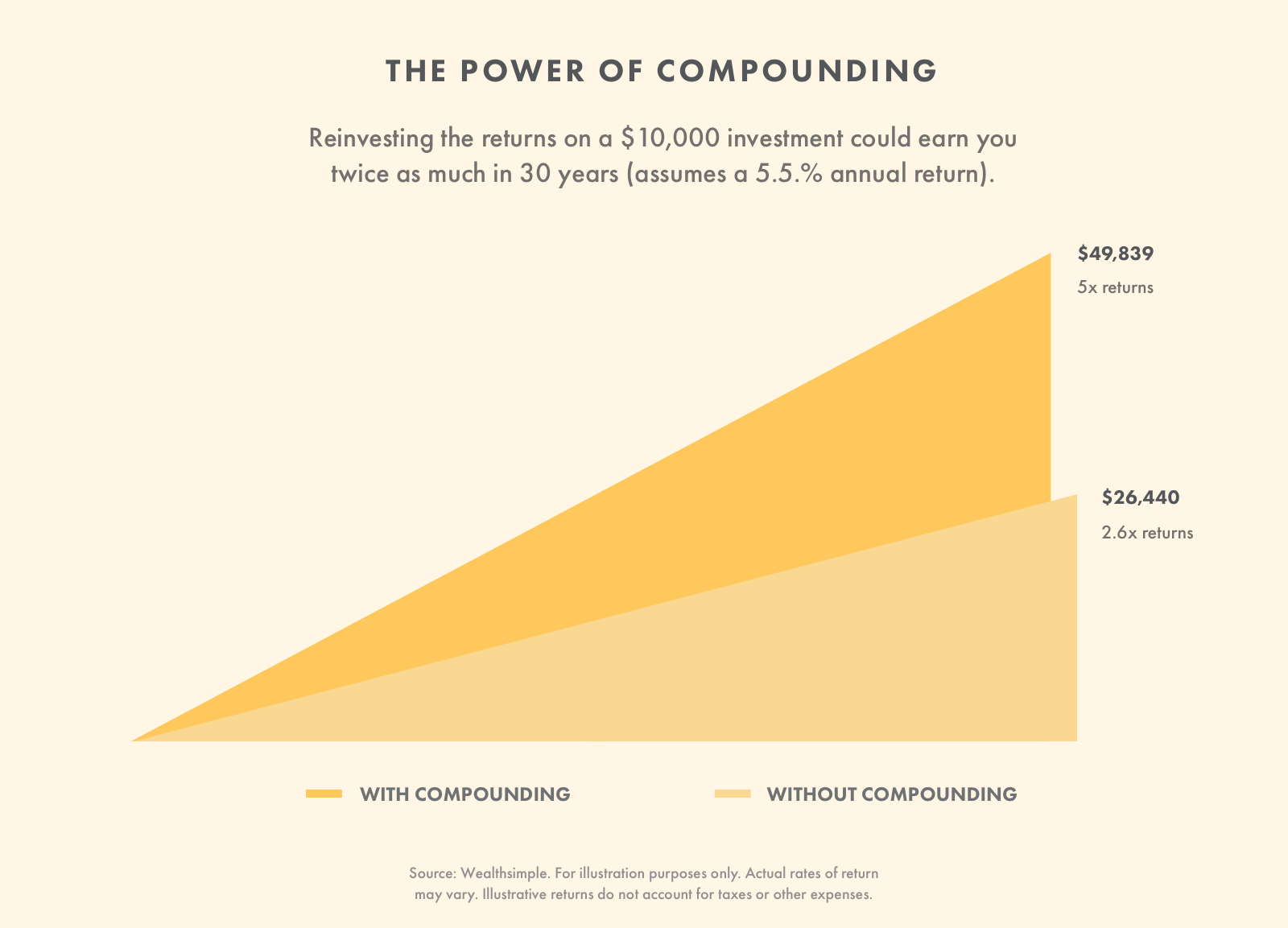If you're fortunate to have an employer or union willing to help you save for retirement, you need to know how a Registered Pension Plan works. This simple savings plan isn’t just a place to park your money. It’s an important investment tool with special tax advantages.
What is a Registered Pension Plan?
A registered pension plan (RPP) is an employer-based savings plan registered with the Canada Revenue Agency. It’s an account where employees and their employers deposit pre-tax income until the employee retires. Upon retirement, the employee can withdraw the money for any reason.
To open an RPP, the employer establishes the plan with a financial institution. The employer has a lot of control here, as they get to pick the financial institution and decide how the money is invested. As the employee, you’re just along for the ride (and the gains, of course!).
RPPs are especially attractive if your employer is willing to contribute as well. Many employers will contribute money to your plan each paycheck. Some will even match your contribution, which makes your contribution the best investment you’ll ever find because it creates a 100% return!
RPPs come in two types: defined benefit RPPs and money purchase RPPs. Defined benefit plans set out a specific pension that the retiree will receive and adjusts contributions to match. Money purchase RPPs allow employees and employers to contribute without specifying a pension amount. Both types of RPP plans are subject to contribution limits. These plans may be structured so that the employee contributes, potentially with an employer match (called “contributory”), or so that the employer only contributes (“non-contributory”).
Most registered pension plans are subject to legislative benefits regarding how they’re managed. These standards are mandated by both the federal government and provincial governments. Remember, the government’s goal is to help you provide for your retirement, so the plans are designed to prevent predatory lending behavior.
The best part about RPPs is that contributions to them are tax deductible. This means you won’t pay taxes on the money you contribute. If you deposit $2,000 to your RPP this year, the CRA will pretend you never earned that money. Ultimately, this means more money in your retirement account. Thanks to compound interest, more money today means a lot more money in the future.

Furthermore, the gains from your RPP are tax-deferred. You only pay taxes when you withdraw them from the plan. During retirement, your income is typically lower than it is during your peak working years. So by withdrawing later, you’ll most likely pay a lower tax rate. Again, this means more money in your pocket.
How Registered Pension Plans work
If you work full time for a company that will contribute to an RPP to help you save for retirement, you’ll need to speak with your employer (or human resources department) to find out how you can participate. They will help you set up an account with whichever financial institution handles RPPs for that company.
If you have a defined benefit plan, your contributions and your employer’s contributions will pool in the pension fund to be invested. When you decide to retire, your employer is responsible for ensuring that you are paid according to the promised payout.
If you have a defined contribution plan, you will have your own account that will hold your contributions and your employer’s contributions. The account will be invested. You usually have some options here. How much you receive at retirement is based on how your investments perform.
Who manages the RPP?
The financial institution your employer works with will manage the plan. That bank will work with a number of in-house and third-party administrators, trust companies, investment managers, and consultants.
What if you leave your employer?
In most provinces, the law says plan members are immediately vested. This means you’re entitled to receive the benefits of your own contributions and your employer’s contributions. You can’t lose any of it.
However, some provinces lack this law, so your employer may require you to work there or be a member of the pension plan for a period of time before you become vested. If you leave before that time period is up, you’ll keep your own contributions, but you’ll lose the portion your employer contributed.
When you leave your employer, you have a few options to manage your vested pension assets. You could…
Leave your assets in the plan.
Transfer the value to another pension plan (if you’re joining one that allows transfers).
Transfer the value to a Registered Retirement Savings Plan or other plan.
Take the cash value (if it’s not locked in).
Do RPPs cost fees?
Yes. Defined benefit plans pay fees out of the pension fund for administration, investment management, actuarial services, etc. If you’re a member of a defined contribution plan, you may pay fees for these services, but they will be built into the general management expenses of the plan. Fees for both plans are typically low—usually less than 1%.
Registered Pension Plan vs RRSP
A Registered Retirement Savings Plan (RRSP) is another way to save for retirement, but it’s not linked to your employer like an RPP. You can set this plan on your own with any financial institution approved by the Canada Revenue Agency. You and your spouse can contribute to an RRSP until you are 71. at that point, you have to roll the plan into a Registered Retirement Investment Fund in order to make withdrawals.
The largest difference between RPP and RRSP accounts is that an RPP is an employer-based account and the RRSP is an individual account. An RPP is managed by a financial service provider chosen by the employer, while investors in an RRSP choose their own provider and plans. Those with RPPs may or may not be able to contribute; if they do contribute, they may receive matching contributions in their account from their employers. Similar to an RPP on this score is the GRSP, or Group Registered Retirement Savings Plan. GRSPs are also employer-sponsored plans.
RPPs and RRSPs have similar contribution and withdrawal rules. Both plans are funded with pre-tax money, which helps your savings grow faster. When your employer puts money into your RPP, he or she will contribute before deducting taxes from your paycheck. With an RRSP, you deduct your contributions from your yearly tax filing. The gains from both plans are tax-deferred as well, so you only pay taxes when you take money out.
RPPs are great if your employer is willing to contribute. But there are a few disadvantages. First, you can’t access that money until retirement. It has to sit there even if you need to cash to pay for emergencies. Second, you can’t choose the financial institution or how the money is invested. Third, you must be a full time employee to qualify.
RRSP are useful retirement tools because you have complete control over who holds the money and how it’s invested. You can also make taxable withdrawals at anytime with no penalty. Above-limit contributions can be rolled over to the next year and you can even contribute to your spouse’s RRSP. The downsides, however, are the contribution limits (based on a percentage of your income) and lack of an employer match.
Which account is right for you? That depends entirely on your situation. Many Canadians enroll in both types of plans. If your employer is willing to match your retirement contributions, you should absolutely open an RPP. It’s free money! If you aren’t employed full-time, you’ll have to open an RRSP or some other non employer-based savings account.
Registered Pension Plan contribution rules
If you have an RPP, your employer will send contributions on your behalf. If you want to contribute as well, you’ll need to make arrangements with your employer to have the proper amount deducted from your paycheck.
RPP contributions (whether they’re made by you or your employer) are not taxed for Canadian residents. Canadians living abroad may have to pay local taxes. If you live outside of Canada, check with the local tax office.
Unlike most investment accounts, the money you earn through investments purchased with your RPP is not subject to capital gains taxes. This means your money will grow tax free as long as you leave it in the account (which is another reason to start investing immediately).
The maximum you can contribute to an RPP depends on the type of plan you use. Defined benefit plans set the payout, which means the contribution amount varies. There is no yearly maximum contribution limit.
Defined contribution plans don’t guarantee a pension amount, but you can choose the amount you contribute. These plans have annual contribution limits that are the same as the limits for RRSPs.
Here are the limits for defined contribution plan contributions and defined benefit payouts, according to the Canada Revenue Agency. We’ve also included the RRSP contribution limits and each year’s maximum pensionable earnings for comparison.
It’s important to note that contribution limits change every year. Check with the Canada Revenue Agency each year to ensure that you aren’t contributing too much. Your online tax filing software may have some information as well.
Registered Pension Plan withdrawal rules
Contributions to a Registered Pension Plan are “locked in.” This means they can’t be withdrawn until retirement.
However, if your employment with the pension plan provider ends, there are a few circumstances where it’s possible to have your plan paid out, depending on your province. For instance, you may get a payout if you aren’t a Canadian resident anymore, have an especially low balance, a serious financial hardship, or shortened life expectancy. Check with your plan administrator to learn if you can get a payout.
Defined benefit RPPs only pay out when you retire. You will only receive the plan’s fixed amount. You will have to pay income tax on these withdrawals.
Defined contribution RPPs will grow as you hold investments, but the gains are not subject to capital gains taxes. However, you will pay income tax on funds you withdraw during retirement. You can withdraw as much as you like at any point, but higher income means a higher tax rate, so withdraw judiciously.
Don’t leave money on the table
Registered Pension Plans are powerful retirement benefits. If you have an employer-sponsored plan, make sure you take full advantage of it. Speak with your employer to ensure you’re enrolled properly.



